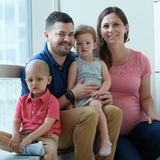Relapsed Acute Lymphoblastic Leukemia: Thomas’ Story
Relapsed Acute Lymphoblastic Leukemia: Thomas’ Story
Only 5 years old, Thomas has endured chemotherapy for his acute lymphoblastic leukemia, and then a more intense treatment round after the cancer came back. He’s gone from a being a terrified 2-year-old to a case study in resilience, and he’s earned the nickname “the Uber driver of the oncology floor.”

The symptoms were there, but no one thought “cancer.” When Thomas was 2, his parents, Megan and Tom, noticed “some bruising, but just on his legs, not weird parts of his body,” says Megan. “He’s a crazy boy! He was jumping off things. I thought, oh, bruising, whatever.”
Then he started getting regular low-grade fevers. An inconclusive trip to the pediatrician was followed by a second visit due to Thomas seeming lethargic and looking pale yellow. It was during a third visit, prompted by a nosebleed, that his pediatrician noticed petechiae — tiny, round, brown-purple spots due to bleeding under the skin — near Thomas’ groin, an unusual spot for them.
The thought was that he had a bad bacterial infection, so the family went to the local hospital’s emergency department. After bloodwork, they were told, “You’ve got to go to Children's Hospital of Philadelphia (CHOP) right away.” Thomas had acute lymphoblastic leukemia, the most common form of childhood cancer. “You realize it happens to children, but it’s so shocking I can’t even explain,” says Megan.
Looking for Something to Blame
At nearly midnight, Thomas was admitted to CHOP. They were seen by Charles Phillips, MD, MSHP, who was an oncology fellow at the time and is now an attending physician with the Cancer Center. “He’s known us since Thomas was 2,” says Megan.
The upheaval of a cancer diagnosis affects everything. “You go from normal living to a world you didn’t know existed,” explains Megan. “Then the questions start: Was it something I did when I was pregnant? Did he eat too many hotdogs? Too much sugar? I wanted a reason. They told me again and again, it’s bad luck, like getting struck by lightning. But you want something tangible to blame, even if it’s yourself.”
Thomas spent six difficult weeks as an inpatient at CHOP. “The first chemo gave him seizures,” explains Megan. For 10 days he was constipated, then had explosive diarrhea that revealed he had a C. difficile infection.
“He was really sick those six weeks,” says Megan. “He was terrified. He got hysterical when anyone came near. It was hard to see, and he’s 2, so you can’t explain to him what’s going on. A physical pain takes over your body. You feel physically heartbroken.” Knowing how long treatment would last, she thought, “I can’t do this for a year.”
Through it all, Cancer Center social workers and child life specialists were offering help, and slowly, the family began accepting their support. Megan stopped trying to isolate herself, and Thomas managed to get beyond his terror and returned to being his active, outgoing self. “Now he’s known as the one who’s never in his room,” Megan says with a smile. “Child life always makes sure there’s a car in his room, and he loves driving it around. He’s called the Uber driver of the oncology floor. It just took him a little while to get there.”
Brutal Treatment, Remarkable Child

Thomas finished his front-line treatment and had been in maintenance treatment for a year and two months when, in January 2018, the cancer returned. “We were prepared,” says Megan. “The doctors were straight with us that this was a possibility.” Because the cancer wasn’t in his bone marrow and the relapse occurred late in his treatment cycle, there were more options. Megan and Tom chose 15 months of intense chemotherapy and cranial radiation — a path with a favorable cure rate.
Unlike the first time, the chemotherapy was administered every week. Megan calls it “brutal.” And sad as well, because Thomas had just started school again: “He loves being out with his friends, and we had to take that away from him again.” Despite being on more than one nausea medication, he would vomit violently.
And yet, this time around he showed steadfast courage. He barely complained — and he even took the time to reassure his little sister. “He’d pack his bags for overnight stays at CHOP, and he’d tell Aubrey, ‘It’s OK, I’ll be back in two days,’” Megan says with pride. “He never fought us on it. He’s remarkable. He’s taught us so much about how to be resilient.”
Almost a year and a half after the relapse, he’s thriving. Along with getting behind the wheel, Thomas enjoys superhero action figures and T-ball. More than anything else, he loves going to school. “He’s in awe,” explains Megan. “He’s been around adults so much. Now he’s fascinated with everything because he missed out on so much.”